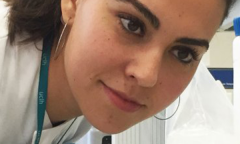Fits and starts: running, falling, fleeing
"It’s May 15th. I have a 10.30 booking at the British Library. I grab a coffee and run for the train. I’m in a rush. My plan since I developed epilepsy is to run for my life. Everything I do is on fast forward. I talk quickly. I move quickly. I eat quickly. I exist quickly. I am a devoted follower of the ‘just in case’ philosophy, except for me it’s not a question of ‘if’, it’s a question of ‘when’. I do as much as I can in the time that I have - soon time will stand still and my life as I know it will be suspended…The fit came without warning. No explanation. No time to grab somebody’s hand as I lunge forward. Then, little by little, things come into focus. There’s coffee everywhere: on my clothes, on my bag, in my hair. My recovery time following a seizure is shorter than it used to be, but I’m not sure whether that’s down to experience or the realisation kids can’t look after themselves and if left alone too long will attempt to boil eggs in the microwave and serve hummus with uncooked corn on the cob." Excerpt From: Franziska Thomas. “Fits and Starts”.
A book about what? Why? Oh! There’s always an oh! I wrote a memoir about living with epilepsy. Living with epilepsy: a contradiction in terms? Would the word ‘surviving’ be more appropriate? Perhaps, for some, for many. When the idea was first suggested to me I laughed out loud. That nervous laugh, the one wreaking of self doubt and ambivalence. Then, after a particularly bad cluster of seizures I decided to give it a go- I had nothing to lose and there’s only so many times you can watch Bruce Willis save the world barefoot.
My early attempts were pathetic, but once I started I couldn’t stop and over time I watched the book take shape. I read autobiographies voraciously- everything from Stephen King and Barbara Taylor to Andre Agassi and John le Carre, some were brilliant, others tedious. I studied every aspect of memoir writing, went on courses, met authors. It occurred to me early on that if I was going to write this for people with epilepsy, people like me, then a medical evaluation of the condition might be useful so I dragged Oliver Sacks’ studies into my research. The history of epilepsy came next: witchcraft and asylums, recantations of experiments and odiousness. There were points at which I had material but no direction and points at which I had direction, but no material. Either way the only way was up, especially when I was down, way down.
The idea for ‘Stream of Consciousness’, which appears at various points throughout the book, came to me after my ten year-old, Oskar, asked for an exact description of what it feels like waking up after a fit. I tried a number of times to pull a few sentences together but none of it made any sense. I soon realised I was trying to rationalise the irrational so I adapted my answer to a running commentary, no punctuation, no breaks: ‘A Stream of Consciousness’. I heard the words rising, then crashing, then burning, then rising again.
For the first year much of what I put on paper were incoherent mumblings. I was writing in the brief moments I had between raising Oskar and Kurt and the moments which passed me by as I lay on the floor. By the end of the day I was so tired I couldn’t keep my eyes open and during the day I rarely had time to eat, let alone write. Sometimes I would fit and forget everything I had written, occasionally I would remember odd moments, no specifics. I started and re-started dozens of times mainly because contrary to popular belief, writing about your condition is traumatising, not cathartic.
The title ‘Fits and Starts’ is if nothing else recognition of what it’s like living with epilepsy and two small children. Nothing runs according to plan, most of what I do is at best chaotic and at worst chaos.
The views expressed here are those of the author and not necessarily those of Epilepsy Society.
Buy Franziska's book on Amazon. An extract is available for free.
You can follow Franziska on Twitter: @FranziskaThoma5
What is epilepsy?
Epilepsy varies greatly and affects everyone differently. If you or someone you know has epilepsy, you may find it helpful to learn more. Here are some basic facts about epilepsy and where to get more information.
Epileptic seizures
There are many different types of epileptic seizure. Any of us could potentially have a single epileptic seizure at some point in our lives. This is not the same as having epilepsy, which is a tendency to have seizures that start in the brain.
Donate to Epilepsy Society
In these challenging times, we rely on donations to ensure vital services for our beneficiaries can continue. If you can spare a donation or pledge a monthly gift, you can help fund research breakthroughs and provide vital support for everyone affected by epilepsy.



